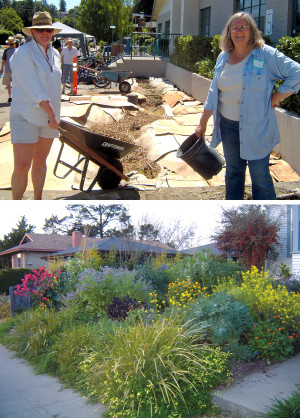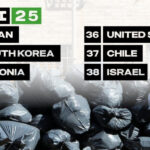
Sally Brown
BioCycle February 2014
At the recent US Composting Council annual meeting in Oakland, I went to a session called “Mulch Madness.” Sounded interesting, and even though I am not a big basketball fan, I got the pun. The session was all about a program in Petaluma, California to save water by replacing lawns with native plants. This was a very timely session as California is now facing a horrific drought. Removing lawns is a great common sense way to introduce a landscape that uses less water. This is how it typically goes: the turf is pulled up (along with a good amount of topsoil) and it is carted away. If it is carted to a compost facility, it isn’t so bad. You can guess what I’d say about landfilling it. Additional topsoil can be added and water thrifty plants are put in to replace the grass.

The City of Petaluma, Daily Acts and Sonoma Compost collaborate on lawn conversions that result in water-efficient landscapes. The top photo shows a conversion in process at the Cavenagh Recreation Center in Petaluma. The bottom photo shows the resulting landscape at a residence.
Photos courtesy of Sonoma Compost Company
The first level of innovation in Petaluma was the decision to bury the grass rather than remove it. Grass consists of organic matter and nutrients — both important ingredients for a healthy soil. Compost, cardboard and mulch are distributed to homeowners. The compost goes over the grass. The cardboard goes over the compost. And finally the mulch goes over the cardboard. The cardboard is a high carbon, naturally degradable material that allows water to soak into the soil but prevents sunlight from reaching the grass. Without sunlight, the grass can’t survive.
The mulch that goes over the cardboard is also an organic material that soaks in water. However it is very low in nutrients. So the plants that you put in the mulch send roots down through the cardboard — helping it to breakdown faster — and into the compost layer and the now dead and decomposing grass to get their food. The grass dies, the new water efficient plants grow and the neighborhood looks great. You are not awakened on weekends by the sound of lawn mowers, and every 1,000 sq. ft native planting uses 25,000 gallons less water than it did when it was planted to grass.
The second was the team put together to implement this plan (also the presenters at the USCC session). A local composter (Will Bakx from Sonoma Compost) partnered with a city official (David Iribarne) who partnered with Trathen Heckman, founder of a local nonprofit called Daily Acts (http://dailyacts.org/). The first speaker in the session was Bakx, followed by Iribarne from the City of Petaluma who is charge of the program. The session closed with Heckman. The two speakers prior to Heckman spoke about how invaluable he had been in making the program a success. However, if you look at the Daily Acts’ website from a more traditional municipal perspective, you’ll see off putting words like “permaculture” and phrases like “personal and financial ecology.”
However, if you listen to Heckman speak or look more closely at the website, you’ll come to realize that the goals and mode of action of this group are not at all “out there” and are both laudable and highly pragmatic. Daily Acts partners with municipalities and works with communities to give people tools to effect change — change that in the Petaluma case as well as in other communities, is exactly what is needed. And change that directly mirrors municipal goals of water conservation.
Burying The Lawn At City Hall
Daily Acts was instrumental in getting 230 volunteers to bury the lawn at the Petaluma City hall and convert it to a native plant, water efficient, pretty to look at landscape. This resulted in 25,000 sq. ft. less turf and annual water savings of 3.5 million gallons. Reduced irrigation and reduced maintenance costs are saving the city $25,000 per year. Daily Acts has realized the potential to partner with the municipality. It also has the wisdom to express its ability to instigate change in terms that will please any member of a municipal agency. At the conference session, Heckman described how responsive people are when given tools, a community and a chance to make a difference. He showed a map with ever increasing numbers of dots to illustrate the number of lawn burial projects that his group has helped to facilitate.
City officials have been clever here too. While there is an upfront cost to supplying the compost, cardboard, mulch and native plants, this is more than compensated for by the costs associated with supplying and treating water. In addition, in order to qualify for the free delivery, residents must first consent to a “WaterWise” house call. Inspectors come and conduct a water audit, identifying things like high flow toilets and showers and leaky faucets.
There are many impressive things about this whole program. Water and money are being saved. The landscape is being improved. There are increasing demands for locally produced compost. Everybody is happy. For me, the most impressive part is the team that has made this program so successful: A public-private-nonprofit partnership breaking down barriers of mistrust to create a powerhouse for change. This is a model that needs to be copied. There are many types of change that must take place and this mixed model offers the potential to accomplish great things even where there is enough water.
Sally Brown — Research Associate Professor at the University of Washington in Seattle — authors this regular column. Email Dr. Brown at slb@u.washington.edu.













